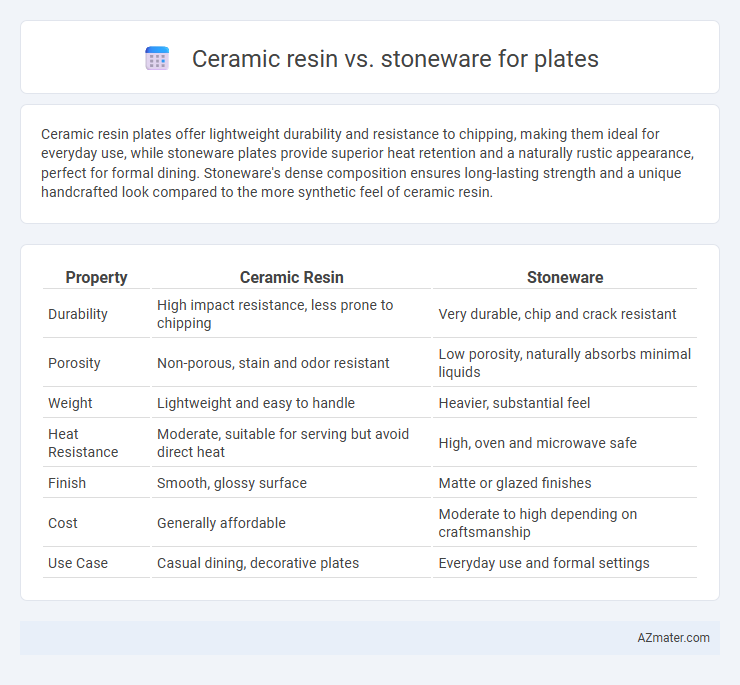Ceramic resin plates offer lightweight durability and resistance to chipping, making them ideal for everyday use, while stoneware plates provide superior heat retention and a naturally rustic appearance, perfect for formal dining. Stoneware's dense composition ensures long-lasting strength and a unique handcrafted look compared to the more synthetic feel of ceramic resin.
Table of Comparison
| Property | Ceramic Resin | Stoneware |
|---|---|---|
| Durability | High impact resistance, less prone to chipping | Very durable, chip and crack resistant |
| Porosity | Non-porous, stain and odor resistant | Low porosity, naturally absorbs minimal liquids |
| Weight | Lightweight and easy to handle | Heavier, substantial feel |
| Heat Resistance | Moderate, suitable for serving but avoid direct heat | High, oven and microwave safe |
| Finish | Smooth, glossy surface | Matte or glazed finishes |
| Cost | Generally affordable | Moderate to high depending on craftsmanship |
| Use Case | Casual dining, decorative plates | Everyday use and formal settings |
Introduction to Ceramic Resin and Stoneware Plates
Ceramic resin plates combine natural minerals with synthetic resin, offering lightweight durability and enhanced resistance to chipping, making them ideal for everyday use and outdoor settings. Stoneware plates are crafted from dense clay fired at high temperatures, resulting in a robust, heavy-duty material with excellent heat retention and a rustic, artisanal appearance. Both materials provide strong alternatives to traditional porcelain, with ceramic resin emphasizing modern versatility and stoneware showcasing classic strength and texture.
Material Composition: Ceramic Resin vs Stoneware
Ceramic resin plates are composed of a blend of ceramic particles and synthetic resins, offering enhanced durability, resistance to chipping, and lightweight properties compared to traditional stoneware. Stoneware is made from natural clay fired at high temperatures, resulting in a dense, non-porous material with excellent heat retention and a rustic aesthetic. The synthetic components in ceramic resin create a more impact-resistant surface, whereas stoneware's all-natural composition provides a classic, sturdy feel but may be heavier and prone to cracking under severe impact.
Durability and Strength Comparison
Ceramic resin plates typically offer enhanced durability due to their synthetic composition, making them resistant to chipping and cracking compared to traditional stoneware. Stoneware, fired at high temperatures, provides superior strength and heat retention but can be more brittle under impact. Choosing between ceramic resin and stoneware depends on the balance between lightweight resilience and the sturdy, classic feel of stoneware.
Aesthetic Appeal and Design Options
Ceramic resin plates offer greater versatility in aesthetic appeal with smooth finishes and customizable colors, ideal for modern, vibrant table settings. Stoneware plates feature a natural, rustic look with earthy tones and textured surfaces, appealing to traditional and artisanal design preferences. Both materials provide distinct design options that cater to diverse style needs, with ceramic resin excelling in sleek contemporary designs and stoneware emphasizing organic, handcrafted beauty.
Weight and Handling Differences
Ceramic resin plates are significantly lighter than stoneware, making them easier to handle and ideal for frequent use or outdoor settings. Stoneware, known for its dense and heavy composition, provides superior durability and heat retention but can be cumbersome during handling and cleaning. The weight difference directly impacts user comfort, with ceramic resin offering a more convenient grip and portability compared to the sturdy, weightier stoneware alternatives.
Heat Resistance and Microwave Safety
Ceramic resin plates typically offer moderate heat resistance, suitable for everyday use but may degrade under extreme temperatures, while stoneware plates are highly heat-resistant, enduring temperatures up to 1200degF (650degC) without cracking. Stoneware's dense, non-porous surface enhances microwave safety by evenly distributing heat and reducing the risk of thermal shock, whereas ceramic resin can sometimes contain additives that might not be microwave-safe. Choosing stoneware ensures better performance and durability for high-heat applications and microwave use.
Dishwasher and Cleaning Considerations
Ceramic resin plates offer a non-porous surface that resists staining and is typically dishwasher safe, making cleaning convenient and efficient. Stoneware plates, while durable, often require gentler dishwasher cycles to prevent chipping or glaze damage, and they may retain food odors if not cleaned thoroughly. Both materials benefit from proper drying and occasional hand washing to maintain longevity and appearance.
Cost and Price Range Analysis
Ceramic resin plates generally cost between $10 and $30, offering an affordable option with decent durability for everyday use. Stoneware plates typically range from $20 to $60, reflecting higher production costs and superior heat retention qualities. The price difference is influenced by raw material sourcing and manufacturing complexity, making ceramic resin a budget-friendly choice compared to the premium finish and weight of stoneware.
Environmental Impact and Sustainability
Ceramic resin plates generally have a lower environmental footprint due to their use of synthetic materials that can be engineered for durability and recyclability, reducing waste over time. Stoneware, derived from natural clay, requires significant energy for mining and high-temperature kiln firing, contributing to higher carbon emissions. However, stoneware's biodegradability and longevity in use often make it a more sustainable choice when sourced responsibly and used over extended periods.
Best Use Cases: Which Plate to Choose?
Ceramic resin plates excel in lightweight durability and are ideal for casual dining or outdoor use due to their resistance to breakage and ease of cleaning. Stoneware plates offer superior heat retention and a rustic aesthetic, making them perfect for formal dining and serving hot meals. Choosing between ceramic resin and stoneware depends on preferences for durability versus traditional appearance and heat retention.

Infographic: Ceramic resin vs Stoneware for Plate
 azmater.com
azmater.com